Phloxes: planting and care, growing from seeds
 Phlox (lat. Phlox) is a genus of herbaceous plants in the family of Polemoniaceae that includes about seventy species and about forty of them are cultivated. In Europe phlox was brought in the middle of the 18th century, since then breeders have created about 1,500 varieties of beautiful and fragrant flowers. Phlox is a Greek word meaning “flame”. This name was given to the plant by Carl Linnaeus in 1737 as the flowers of some species are extremely bright.
Phlox (lat. Phlox) is a genus of herbaceous plants in the family of Polemoniaceae that includes about seventy species and about forty of them are cultivated. In Europe phlox was brought in the middle of the 18th century, since then breeders have created about 1,500 varieties of beautiful and fragrant flowers. Phlox is a Greek word meaning “flame”. This name was given to the plant by Carl Linnaeus in 1737 as the flowers of some species are extremely bright.
Phlox is native to North America and its harsh climate made this plant easy-to-grow and tenacious. In addition, phloxes are very fragrant and bloom for a long time.
Description of phlox flowers
Description of phlox flowers Even belonging to one species phloxes can be very diverse: their look changes depending on the climate in which they grow. For example, at an altitude of 2.5 miles they are moss-like and low-growing, their stems are branching and covered with evergreen leaves, and the height of plants is from 2 to 10 inches. In more favorable conditions, phloxes are upright shrubs with a height of 11.8 inches to 6 ft. And phloxes can be half-shrubs. Phloxes are classified by the time of flowering: they are spring (early), summer (mid-season) and summer-autumn (late). The varieties of upright-growing phloxes are cultivated most of all. Their leaves are sessile, opposite, entire, oval-lanceolate or elongate-ovoid. Flowers of phloxes are from 1 to 1.6 inches in diameter, have a tubular funnel-like shape and are collected in complex inflorescences up to 90 pieces in each. The flowers have five bent petals, five stamens and one pestle. The fruit of phlox is an oval capsule. All cultivated phloxes are perennial plants, and only Drummond's phlox (Phlox drummondii) and its numerous varieties are annual.
Types and varieties of phlox
Annual phloxes
Drummond’s phlox is one of the best annuals among the garden flowers. Being discovered in Texas, it was brought to England by a Scottish traveler, naturalist and theologian Thomas Drummond in 1835. In England the flower took root. Drummond’s phlox blooms from June till the frosts. Its leaves are oval-lanceolate, opposite. Thin branched stem is from 4.7 to 11.8 inches high. Fragrant flowers are violet, dark red, white, yellow, salmon.
 Drummond’s phlox
Drummond’s phloxDrummond’s phlox is represented by two types: star-shaped and large-flowered. ФStar-shaped Drummond’s (Phlox drummondii cuspidata) usually reaches 11.8-15.7 inches in height, although low-growing (up to 4.7 inches) varieties are known. The petals of its bright flowers are beautifully dissected, and the flowers look like a star with an eye. Large-flowered Drummond’s phlox (Phlox drummondii mixed) grows up to 11.8 inches in height. It has large flowers of different colors, but red flowers are especially attractive.
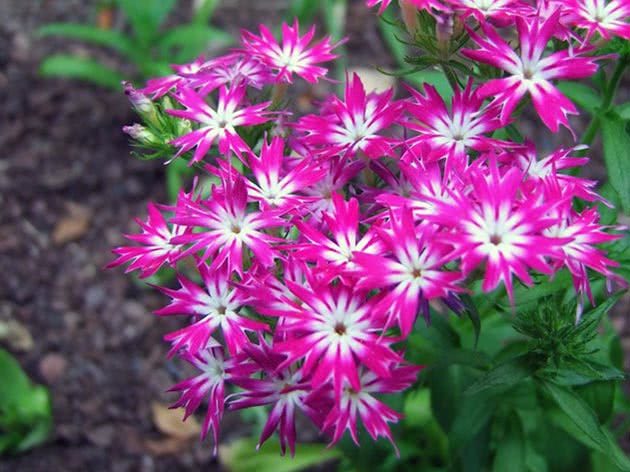 Drummond’s phlox
Drummond’s phloxSome growers classify annual phloxes by their size into large-flowered and dwarf (6-7.8 inches tall). Among the large-flowered varieties there are High White, High Fiery Red and High Bright Red. Compact low-growing varieties (dwarf varieties) are represented by Snowball (white), Shamoa (pink), Isabella (yellow), Salmona (salmon), Defiance (fiery red). Both large-flowered and star-shaped types have double and semi-double varieties. Promise is a popular variety of double phloxes.
Perennial phloxes
Among perennial varieties of phlox creeping phlox (phlox subulata) is the first to bloom (in May). The flowers of different shades from snow-white to dark-red heavily cover densely branched stems and completely hide that leaves that are narrow, awl-shaped (the Latin word from its name “subulata” means “needle-shaped”). This variety of phlox is planted in rock gardens and on alpine hills. Wide blue phlox also blooms in May, one or two weeks later. Its little bushes with delicate lilac-blue flowers look very elegant. This species is not so sun-loving as creeping phlox. It has lignified stems, larger, but less dense leaves. Perennial phloxes are also represented by such species as garden phlox, blooming in the middle of summer. This is a well-known phlox with huge fragrant heads of flowers and beautiful green leaves.
 Creeping phlox
Creeping phlox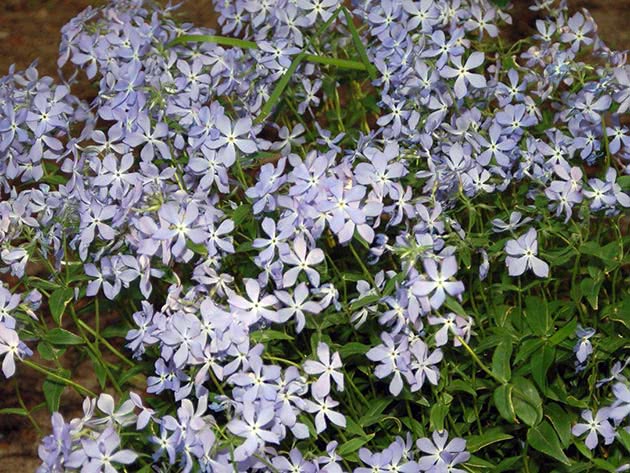 Wide blue phlox
Wide blue phloxGarden phlox
is the ancestor of many exquisite varieties, among which there are double phlox Pure Feelings (large inflorescences of white flowers with a green stripe in the center, the underside is lilac; petals are elongated, twisted, the height of the plant is 2.3-2.6 ft) and double phlox Natural Feelings (very small white-green-pink flowers, inflorescences resemble a branch of lilac). The result of the selection work is such winter-resistant varieties as phlox Orange (Orange Perfection, Orange Spat) of orange-red shades that do not lose brightness in the sun. It is easy to breed and care for them. They are incredibly beautiful. But curiously enough, the most popular variety among the florists is phlox King, up to 3.3 ft high with flowers up to 1.6 inches in diameter, in colors of crimson, pink, lilac, white and other.
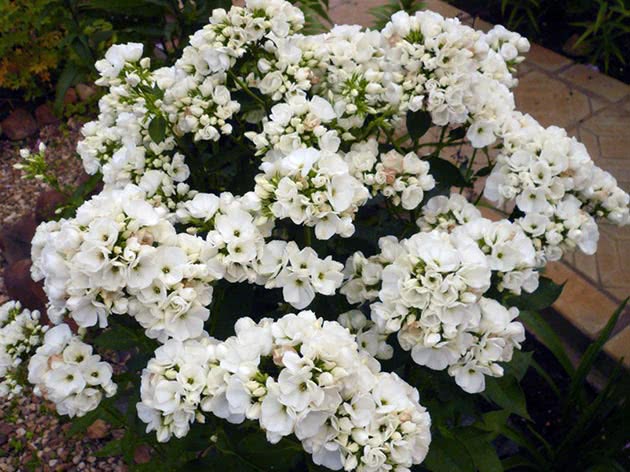
Growing of phlox from seeds
It is possible to have flowering phlox in the garden from spring till the end of September, you just need to know how to grow phlox. Phloxes are mostly propagated vegetatively through cuttings, layers or bush division, but some growers prefer growing of phlox from seeds. Seeds of perennial phlox, collected on the eve of autumn, must be sown in the ground before winter in November-December. Choose a planting site where your phlox will grow for several years. If there is already snow on the site, remove it from the garden and sprinkle seeds over the frozen ground at a distance of 1.6-2 inches. Sprinkle a 0.4-0.6 inch layer of sifted soil over the seeds, and cover it with snow. The soil can be prepared in advance, so it will not be cold and frozen, or you can buy the soil in the store. The germination of seeds sown in winter is 70%, by spring their germination capacity sharply decreases. Early in spring sprouts will appear that will need to be pricked out after the appearance of two pairs of true leaves at a distance of 7.8 inches from each other. You will plant out these seedlings in due time.
Mostly annual phloxes are propagated by seeds. In spring, prepare a bed, sprinkle seeds 1.2-1.6 inches apart, water them from a sprayer, cover them with polyethylene. Do not sprinkle the soil over them, but every day, lift up the foil for a short while, shaking off the condensate from it, so that the seeds can breathe. Once the seeds are sprouted, the polyethylene can be removed.
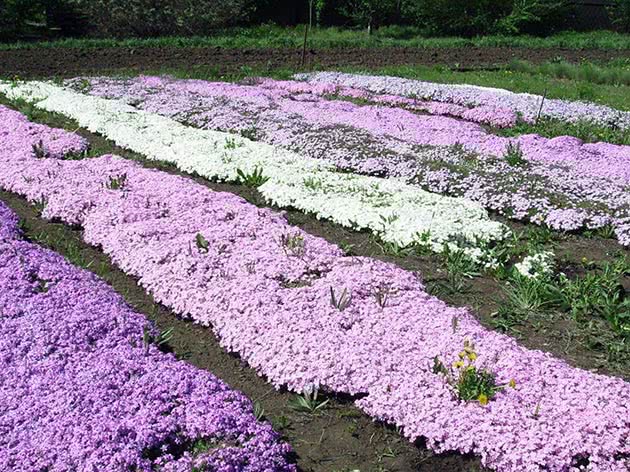
Annual phlox – planting and care
Planting of annual phlox
We have already described how to grow phlox from seeds. But some growers do not want to expose the seeds to risk for fear of strong spring frosts, so they plant seedlings of phlox in spring. To get seedlings the seeds of phlox are sown in March, the sprouts appear in a week. Sprouted seedlings need light, watering and a moderate temperature. In two or three weeks the shoots are pricked out. In the first days after pricking, try to protect the shoots from direct sunlight in order to avoid burns. Cover them with a newspaper or an opaque foil. Before planting of phlox seedlings in the open ground, you should feed the seedlings with mineral fertilizers two or three times. The concentration of fertilizing solution should be two times weaker than for an adult plant. To promote bushier growth at the stage of 4-5 leaves the shoots are pinched.
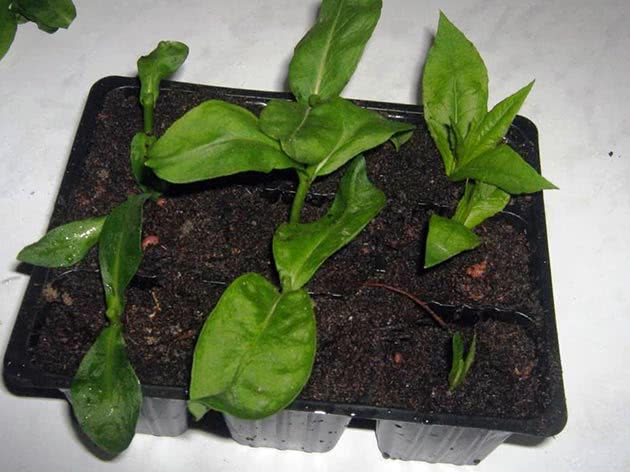
In May, the grown-up seedlings of phlox are planted out on the bed at a distance of 6-7.8 inches from each other. It is very important to choose the right place for planting. Annual phloxes are cold- and drought-resistant, love light, but do not tolerate overheating of the root system. The most beautiful phloxes grow in the dappled shade, and the thicker the shade is, the less abundant but the longer the phlox flowering is. In the sun, the flowers of phlox quickly lose their brightness; in the partial shade they keep the color strength for a long time, and if you plant the so-called "bluish" varieties the flowers of which become almost blue in the twilight, you will get an incomparable aesthetic pleasure from the phloxes grown in the partial shade. It is the best to plant phloxes on high beds, far away from trees and shrubs with a highly branched root system.

Garden soil for phloxes should contain a large amount of humus. Heavy soils with poor drainage are fatal for phlox. They do not like acidified areas, in this case lime will need to be added to the soil. The best composition of the soil for phlox is fertile sand without clay impurities, with an adequate watering. This will let you grow powerful flowering bushes. If the soil is heavy loam, you will have to add sand, organic fertilizers and peat into it. Add bio-humus or compost (or two handfuls of ash) into the planting hole, plant a phlox seedling with the roots straightened horizontally.
Care of annual phlox
Growing of annual phloxes is a pleasant and easy-to-do task. The main thing is not to stop them from growing. The rest of the care is cautious loosening of the soil (6-8 times) that is usual for all flowers, earthing up during loosening in the second half of the growing season for the root system of phloxes to get formed quickly, feeding with organic and mineral fertilizers. The first top dressing with liquid manure (0.9 oz per bucket of water) is carried out at the end of May. The second is in early June, but potassium salt or superphosphate should be added to the solution of manure. The third one (liquid manure without additives) is in the beginning of July. The fourth top dressing takes place at the end of July and should contain phosphorus and potassium salt.

Phloxes need a regular and moderate watering in the morning or in the evening. It is necessary to pour water under a root at the rate of 1.5-2 buckets per 11ft². It is fatal to water phlox with cold water in the daytime heat, because the stems can crack. It is advisable to remove spent flowers that prevent the growth of the new ones. As for diseases and pests, phlox have plenty of them.
Diseases of phloxes
Such a disease as Alfalfa mosaic causes an unusual pattern on the petals of phloxes, disfiguring the appearance of the plant. There is no remedy for this disease, so the bush is dug out and destroyed in order to prevent the disease from spreading. The same sentence will have to be carried out if it is found that the plant was affected by powdery mildew, a fungal disease, that covers the leaves and stems with whitish deposit.
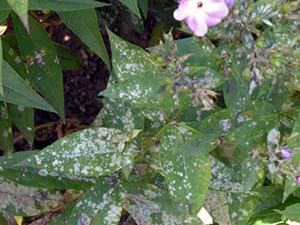 Phloxes suffer from one more fungal disease such as phoma leaf spot that makes the shoots brittle and the leaves dry. As a preventive measure, it is suggested to spray colloidal sulfur on the leaves and stems of phlox (not on the inflorescences), but the air temperature should be at least 64 °F. Septoria blight manifests itself as dark brown spots on the leaves of plants that increase in size with the development of the disease. At the first signs, sprinkle the bush and the soil around it with Bordeaux mixture, and in two weeks repeat the treatment. Another disease, verticillium wilting, destroys the root system of phlox, but only phloxes growing on acidic soils suffer from it.
Phloxes suffer from one more fungal disease such as phoma leaf spot that makes the shoots brittle and the leaves dry. As a preventive measure, it is suggested to spray colloidal sulfur on the leaves and stems of phlox (not on the inflorescences), but the air temperature should be at least 64 °F. Septoria blight manifests itself as dark brown spots on the leaves of plants that increase in size with the development of the disease. At the first signs, sprinkle the bush and the soil around it with Bordeaux mixture, and in two weeks repeat the treatment. Another disease, verticillium wilting, destroys the root system of phlox, but only phloxes growing on acidic soils suffer from it.
Pests of phlox
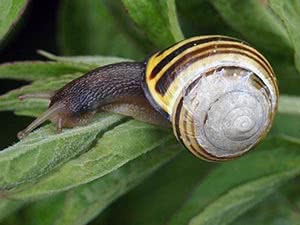 Mostly phlox is attacked by nematodes, a tiny thread-like worm that sips the sap. Inflorescences get disfigured, flowers get smaller, the stems get thinner. The affected bush will have to be dug out and burned, and the contaminated soil should be treated by nematicides three times with an interval of 20 days. Phlox can get harmed with land slugs, eating the bottom of the stems, leaves and even flowers at night. They live in the upper layers of the soil, so the preventive loosening of the soil and weeding will be quite effective means of fighting with slugs, but if they did appear on the site, dust the soil with slaked lime, ash or a mixture of ash and tobacco dust. If phloxes are damaged by butterfly caterpillars, it is better to collect them manually, but if there are too many of them, then treat phlox with pesticides for leaf-eating pests.
Mostly phlox is attacked by nematodes, a tiny thread-like worm that sips the sap. Inflorescences get disfigured, flowers get smaller, the stems get thinner. The affected bush will have to be dug out and burned, and the contaminated soil should be treated by nematicides three times with an interval of 20 days. Phlox can get harmed with land slugs, eating the bottom of the stems, leaves and even flowers at night. They live in the upper layers of the soil, so the preventive loosening of the soil and weeding will be quite effective means of fighting with slugs, but if they did appear on the site, dust the soil with slaked lime, ash or a mixture of ash and tobacco dust. If phloxes are damaged by butterfly caterpillars, it is better to collect them manually, but if there are too many of them, then treat phlox with pesticides for leaf-eating pests.
Perennial phlox – planting and care
Planting of perennial phlox
Growing of perennial phlox is not much different from growing of annual phloxes, but still there are some points. For example, the spring planting of perennial varieties is carried out in the same way as of the annual ones, but after that the planting site must be mulched with dry peat or humus. In addition, the distance between plants should not be 6-7.8 inches, but at least 1.6 ft, because the phloxes will grow on this site for many years, and they will need a room to grow. If you buy phloxes in autumn, then do not plant them at once, but slightly cover them with soil to a depth of 6-10 inches on the site protected from the wind with much snow in winter. Once the soil freezes, cover the phloxes with peat or dry leaves.

In addition, in some cases planting of perennial phloxes is carried out in autumn. For example, if the bush has greatly grown and has lost ornamental beauty, in autumn (from the middle of August till the first ten days of September) dig it out, divide the rhizome, remove the middle of the bush that grows old earlier than other parts, and plant out the side parts. Also in autumn phloxes grown from the spring cuttings should be planted on the permanent place. Before the autumn planting, compost is added to the soil; if there is a clay loam, then also add sand; and if the soil is sandy, then add some peat. At the distance of 1.6 ft from each other cuttings are placed not deeper than 1.6-2 inches with their roots straightened horizontally. If there is no rain, planted phloxes are watered abundantly at the rate of 3.5 pints of water per bush every 2-3 days for two weeks, the dried up soil is loosened and mulched with 1.6 inches layer of peat or humus.
Care of perennial phlox
Care for perennial phloxes is the same as for annual ones. But if annual phloxes need to be fertilized four times during the growth period, perennial species are fertilized five times – the last one is in the period when the seeds are formed in the capsules. Phloxes are fed with potash phosphorus fertilizers (0.4 oz of potassium sulfate and 0.8 oz of superphosphate per a bucket of water). Do this in the evening after watering, avoiding the leaves. With proper care and good feeding, phloxes grow on one place, without losing ornamental beauty, for up to seven years.
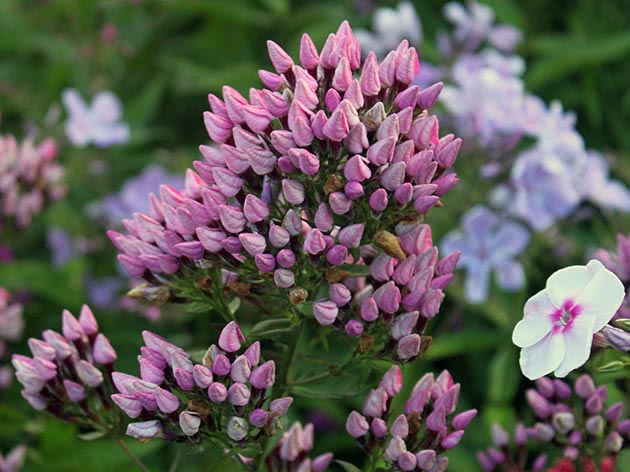
Perennial phloxes are one of the rarest cultures that produce cuttings during the entire growing season. You can start from the moment when the shoots are 2 inches long, the last cuttings are made at the end of September. You should keep in mind, however, that spring and summer rootings are more successful than later ones. In addition to propagation from cuttings, phloxes are propagated by layers, and this method is much less labor-consuming than cuttings. The stem before fading is bent to the ground, fixed along the entire length and covered with humus and peat. In autumn a new plant is formed by this shoot, it is separated from the main bush and transplanted to where it will grow permanently.
Phloxes in winter и после цветения
Annual phloxes can bloom the next year, but the quality of the inflorescence is unlikely to be high. Therefore, if you want, collect the seeds, cut off the dead leaves in autumn, and dig up the ground on the site, removing the rhizomes of phloxes from it. In spring you will be able to sow the collected seeds, and the flowers you like will bloom again.

Perennial phloxes, or rather their growth buds, can freeze in the snowless winter if the temperature drops to 14-5 ºF, and if the frost reaches -4 -13 ºF, the rhizome of phlox will die. Therefore, in autumn, after the foliage of the phlox has yellowed and withered, cut it off, and sprinkle the root collars with a layer of soil with peat. Cover them with straw, fallen leaves or fir twigs to protect the rhizomes in the ground until the spring. If there is an 1.6-2 ft layers of snow, then you can not be afraid of -22 ºF frost.
